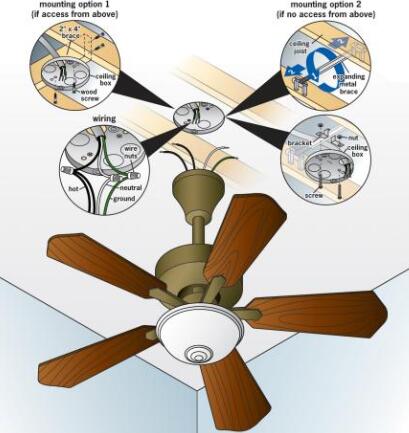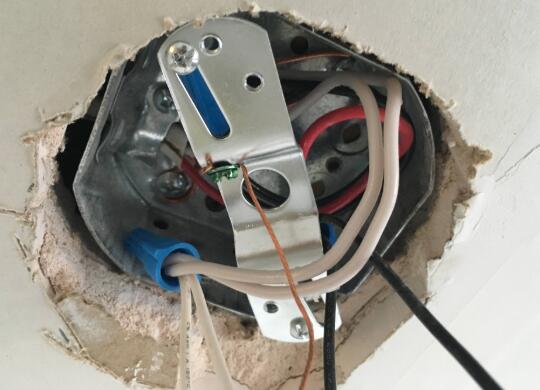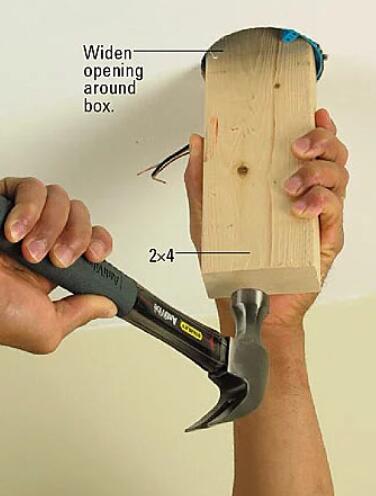If you want to install or replace your house ceiling fan box, Safety is a key to avoid unnecessary accidents. Try to figure out all the electrical wires connected in the ceiling and before you embark on your work, shut off the power. Always confirm that the site has no obstructions. You also required to choose the right fan box, either a plastic or a metal made depending on your desires. We will equip you with all the requirements and give a detailed step for a good installation on the ceiling fan box.
How to Install a Ceiling Fan Box?
You should have a circuit tester, drilling tool, ladder, box brace, fan-rated box, wrench pliers, screwdriver and a pry bar.
Here are the steps you should follow:

1. Ensure that the power is turned off at the circuit panel
Once you have pointed the best position of your installation, turning off the electricity at the circuit panel is a safety precaution. Use your circuit tester to confirm that the power is surely off. Besides, seal the switch to avoid possible turning on, especially when you have your kids around or anyone around your working area.
2. Drill the installation site
If you are installing for the first time, you have to drill through the ceiling to avoid damaging the ceiling carefully. Once you have drilled the hole, try to smoothen its curvature. If you are replacing the old box, use a hammer and a handheld drilling tool to drill around the old one. Remove all the screws using a screwdriver. Loosen the box carefully by smooth hammering to prevent the ceiling from cracking.
3. Brace installation
Installation is done by slipping the brace into the hole. Hold the shaft of the brace and rotate it slowly while observing its behavior. Rotate it until it comes in contact with joist and ensures that it comfortably fits with the ceiling. Depending on the weight of the fan, always choose a heavy-duty one for extreme support. Use a wrench to tighten the brace and attach it with the bolts then tighten it up. This installation depends on where you have access, either from the above or below the ceiling.
4. New box installation
Once you have successfully installed the brace, fan box installation will depend on whether you are working above or below the ceiling. Insert the fan box into the hole then uses the screws to firmly attach it to prevent from making noise if left shaky. There are a variety of boxes including, a pancake box and fan-rated plastic box.
How to Tell if the Outlet Box is Ceiling Fan Rated
Most of the people always take the cost as the only determinant when choosing their box. There is a multiple recommended way of telling whether the box supports the ceiling fan. We’ve sampled out the best ways that will help you to determine if the outlet box is fan rated.

The design of the outlet boxes
These boxes are specially engineered in a unique way. They have braces that are screwed into the joists, and a has a nipple-like located in the middle of the box which facilitates lateral movement on the brace. This feature is always notable on the day of installation, so you have to be keen when choosing your outlet box. It is advisable to inspect it constantly.
10-32 size screw
This is the basic way for checking if it’s a fan rated box. The screw holes should fit a 10-32 screw size, and if it is a ceiling box, it should fit an 8-32 screw size. The selection of the screw will only be determined by the weight of the fan you intend to install. It is advisable to one supplier of screws and the outlet box.
Requires support
As you choose, the fan that weighs more than 35 pounds requires support. It is always acceptable for an outlet system that supports the entire fan. The importance of this support to keep a firm hence avoiding any possible occurrence of an accident in your operations, also allows you to have a safe working area. It is always indicated that any support is acceptable, either marked or in the instructions provided.
Manufacturer’s indication
The manufacturer always marks the outlet boxes. It always indicates the suitability and discourages its misuse. Since they are designed to support suspended fans, the manufacturer always gives a direction on the maximum weight of the fan support. Always confirm the markings for a better fan fixing.
What is the Little Black Box Inside My Ceiling Fan?
The black box is a wattage regulating component. It is characterized as a safety precaution, including the protection of the fan from overheating hence curbing any possibility of fire break out. The installation of these regulators is a requirement of federal law.
The Purpose of the Black Box
This component works in a way such that if you install a high wattage bulb that exceeds the recommended, it will automatically shut off the bulbs. Sometimes instead of shutting off, it may just regulate the wattage they receive. With this feature, you might not encounter any breakage. The black box has sometimes been misunderstood; it neither control the speed of the fan nor the brightness of the lights. If you want to install a high wattage bulb, you can remove the wattage limiter. Know that it is risky to overload your fan with bulbs. Confirm that the circuit is turned off for safe removal or bypassing it.
How to Mount a Ceiling Fan Box

When mounting a ceiling fan box, you should always consider the metal made box. Be sure to choose the right size and shape you prefer that will offer enough space for wire connection. Here are the guidelines that you should follow when mounting a ceiling fan box.
First, identify the joist, which will offer proper support to the fan regardless of its weight. Mount the ceiling box to the joist, depending on the status of the fan you want to install, choose the screws properly, go for the one that will give a good holding.
Install a hanger bracket, which will give you a good allowance for dealing with the wires. For the beams that are exposed, a ceiling box can also be mounted directly into it regardless of how slanted it is.
When passing wires through the fan box, one hole should be used to bring in the wires while the other hole should send them out of the box. Make sure you employ the use of wire nuts to keep the wires in place and protect the fan box against sparks.
How to Fix a Loose Ceiling Fan Box
A loose ceiling fan box is a safety hazard since it can damage the wires inside the box. It can be caused by the vibrations as a result of a ceiling fan. A fan that is installed to the box that doesn’t match with the designed loads can also loosen the fan.
Before making any step, try to figure out how the fan is mounted, and if the box is metal or plastic, it has a different approach.
Here are the steps you have to be armed with; turn the entire power off.
- Confirm using the circuit tester, whether it is off, and seal the switches. Lower the plate that covers the box. Once you have lowered the canopy, try to identify the bolts, nuts, or screws responsible for holding the box.
- If you discover that the fittings are loose, take a step of tightening them. As you tighten, be careful not to interfere with the fixture since you will have to get it back.
- Check whether you’ll be required to add additional support when tightening them. Test whether the ceiling box is still loose and if not return the fixture into its original position.
- You are also required to confirm the U-bolt condition if needed to be tightened and the screws holding the bracket. You can add the screws to hold the bracket into its position.
What Type of an Electric Box for a Ceiling Fan?
There are a variety of electric boxes, and it can be a metal or plastic made. They are made from different materials depending on their usage, and the outdoor boxes are always made of aluminum since it is weatherproof. Some are made of PVC. Here are some factors you should consider when looking for an electric box.
1 The cost
Electric boxes come at different costs. Generally, the cost is always determined by the quality of the box. The material used in manufacturing always dictates the price. If you compare the one designed to overcome any weather condition, including the aluminum and the plastic made indoor boxes, you’ll realize that aluminum made will be costly. Look for the one that accommodates your budget.
- Depth Adjustable
- Quicker to install than a nail on box
- Extra thick wall material creates stability and rigidity
- Easily removed without creating damage to wall
- UL ListedMadison Electric is now part of the Southwire family Product packaging may vary
2 Durability
This comes into play whenever you want to add the bulbs or when your electric box becomes loose regularly. When tightening the electric box, it always wears especially the screw holes. Metal boxes are always preferred since it doesn’t wear easily. A loose ceiling fan has an impact on the electric box, and if it’s of low quality, you will automatically need to replace it.
- Saf-T-Box allows safe, simple installation of fans and fixtures, ideal for new construction and where attic is accessible
- Supports ceiling fans up to 70 pounds or lighting fixtures up to 150 pounds
- Includes three knockouts for Conduit or Romex, one Romex clamp
- 15.5-cubic-inch wiring capacity, electrical box is 1-1/2 inches deep
- Includes Saf-T-Cap, mounting hardware and instructions
3 A fan rated electric box
A fan rated box can be easily identified. The manufacturer always marks it, showing the weight range of a fan it will support. It is always designed to hold a ceiling fan of more than 35 pounds. The importance of these factors is that the manufacturer always recommends other precautionary components such as the wattage limiters.
- FULLY ADJUSTABLE BRACKET - For installations between joists or rafters spaced from 16" to 24" on center. Bracket ends bite into the wood rafter or joist, holding the fan or fixture securely in place.
- NO ASSEMBLY REQUIRED - No parts to lose...installation screws ship captive, with an installed mud cover and NM cable connector.
- PLATED STEEL CONTRICTION -Fast, easy installation in old work/retrofit projects
- LOAD RATING - UL Rated: 70 lb fan/ 90 lb fixture at 24" o.c. and 70 lb fan/150 lb fixture at 16" o.c. CSA Rated: 50 lb fan/ fixture
- SPECIFICATIONS - Weight: 3.184 lbs/each - Height: 3.563" - Width: 13.979" - Style: 2" Box Depth
4 The warranty for the product
The consumer is always covered in case the electric box is doesn’t function properly. Always observe the expiry date of the warranty before purchasing it. For assurance, it’s recommended that you check the reviews on how the buyers reviewed the seller or the manufacturer. Be conversant with the warranty policies and the guidelines laid down in the manual provided by the seller.
What Uses More Energy, Ceiling Fans or Box Fans?
It is necessary to consider an energy-efficient fan for favorable electricity consumption.
The energy consumption of a box fan can be high compared to the ceiling fan. This comparison is dependent on several factors.
The ceiling fan energy consumption always depends on fan size. Since ceiling fans have different sizes of blades with different energy consumption, such as a 48 inch will consume about 75W. It is advisable to purchase the ceiling fans under the Energy Star approval.
Recommended Energy Efficient Ceiling Fan
- Includes integrated light kit that is cased in elegant White Finish
- Designed for large rooms up to 400 sq. Feet and equipped with installer's choice position mounting system for standard, or flush mounted
- The Indoor Ceiling Fan delivers ultra-powerful air movement, so you get the cooling power you want.
- The motor can be run in reverse to aid operation in winter to move warm air down from the ceiling.
- 37 Year in Ceiling Fan and Solar Industry (Not Fly By Night)
The consumption of a box fan varies, and the manufacturer normally indicates it. Its consumption can go up to 200W. In addition to that, the blades, size, and the motor also determine energy consumption.
Recommended Energy Efficient Box Fan
- 3-SPEED FAN CONTROL: Rotary 3-speed fan control makes it easy to optimize air circulation and airflow to suit any home or work space.
- SAFE AND DURABLE CONSTRUCTION: The high-performance blades on this fan allow for smooth operation and are covered with a safety grill for protection while in use.
- SAVES MONEY AND ENERGY: This 3-speed box fan helps save money and reduce energy consumption by assisting air conditioners with full-force air circulation.
- LIGHTWEIGHT DESIGN: The lightweight construction and convenient carrying handle makes it easy to transport as needed.
- MANUFACTURER WARRANTY: With confidence in the quality of our product, Pelonis offers a 1-year manufacturer with your purchase of any of our product.
How to Remove a Ceiling Fan Box
- The first step is to cut off the electricity supply to the ceiling fan box.
- Verify using a circuit tester that, indeed, the power is off.
- Determine how the box was fitted or attached. Sometimes the box might have been attached to the joist by the nails or screws.
- Loosen the screws, and if it is nailed, strike it with the hammer. Carefully remove the ceiling box.
What Size Electrical Box for Ceiling Fan
The size of an electric box can be small, a bigger one. It is good to choose a proper sized should be used. This will help you to avoid the loosening of the connection, and it can also damage the wiring system. The size always depends on the weight of the ceiling fan you want to install. A high weight fan would require a larger size of the box. The size selection also depends on the expected bulb addition; if you require an allowance for the addition of bulbs, you will have to consider a high sized electrical box.

Conclusion
Installing proper running ceiling fans entails a variety of factors that you should be armed with. Know how to position your fan, breakages you might encounter, proper size determining, and the components accompanied with. It is necessary to know how to fix it whenever you encounter a problem, which will save you from unnecessary spending. Have your tools around your home and always keep the manuals that are always accompanied by the product you buy.
You May Also Like:





